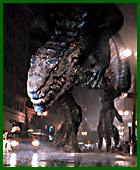Although the 1/6 scale upper body moved very quickly in real-time, whenever it was called on to interact with miniature cars and structures, the cameras were rolling at extremely high speeds, which slowed the creature's actions down considerably. "We would've had to have a creature that moved three times faster than real-life to be able to get it to work at the high-speed the cameras were running at," Tatopoulous laments. "The big creature was completely computer linked, so we could record a bank of movements, edit them and replay them, but we were limited in the amount of times we could use the 1/6 scale creature."
Speed was not an issue with Godzilla's progeny, a nest-full of "Baby 'Zillas" hidden deep in the bowels of Madison Square Garden, who bear no relation to the cuddly, smoke-ring-blowing Tadzilla of the Toho movies. Instead, the Baby 'Zillas are more like a foul tempered pack of raptors. The design of these enfant terribles was actually quite different from their infamous parent. "I wanted them to look more like embryos than newborns, they looked eerier that way," Tatopoulous states. "They weren't bulky at all, the Baby 'Zillas looked really thin and sleek, with thin limbs. But like a human baby, the scale of the head and legs were much bigger proportionally, so it became an insane looking suit. You could never tell there was someone in there."
The 1:1 scale were actually the first creatures Tatopoulous and company produced, since they had to work on set with the film's stars. Tatopoulous Designs Inc. constructed eight man-in-suit Baby 'Zilla costumes and four hydraulically animated mechanical puppets. As he would later employ for the 1/24 scale man-in-suit Godzilla, Tatopoulous used foam latex skins laid over a foam rubber and bungee-cord structure, and leg extensions to give the creatures' limbs the proper three-jointed lizard-like look. Ironically, it was the Baby Zilla costumes that were more limited in their movements, and thus largely used for breaking out of their eggs. Within an hour or two of hatching, the Babies are considerably more agitated, and a combination of computer graphics and hydraulically powered puppets delivered the lethal goods on-screen. Sometimes the animatronic version's performance was a little too real for comfort, like when Matthew Broderick ducked inside an elevator and a Baby thrust its head in just before the door closes. "Our hydraulic baby was made to actually break through doors and trash things," Tatopoulous proudly explains. "They moved extremely fast, with snapping predator-like movements, and weighed probably 400 pounds. At one point, the elevator door, which was manually operated, didn't open on cue and the Baby crashed through and completely destroyed the door. We got this on film and it was very interesting to see Matthew Broderick, who wasn't expecting this, and he was freaked out! We realized how lethal the Baby was at one-to-one, so we had very high security rules, nobody was allowed in the perimeter of motion of the creature because it could've killed, no problem."
Although Tatopoulous designed and built the aliens and designed the spacecraft for ID4, in retrospect Godzilla was a much more demanding project. "I didn't realize myself at the beginning how involved it would be," Tatopoulous admits. "It's like designing the lead actor in the movie, and I had to make sure he looked great everywhere. I came out of the show much more exhausted than after ID4, maybe because I had more responsibility. That said, this was also the most exciting project I've ever done."
